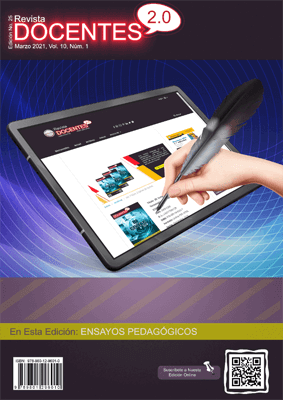Neurological Implications and Effects on Language Development
 DOI:
https://doi.org/10.37843/rted.v10i1.178
DOI:
https://doi.org/10.37843/rted.v10i1.178
Main Article Content
Abstract
Language, from its conception as a communication system, is shown to be involved in all areas of the human being. In particular, in the educational processes, where it forms the basis of any learning. Despite this, little research has been done on language disorders at the neurological level. With this objective in mind, this article carried out a theoretical study regarding the neural characters involved in the development of human speech, as well as the most common problems that arise in this area. In this way, it was sought to provide educators with theoretical support that allows them to guide their procedures when treating conditions of this type in students of formal education, especially through didactic strategies based on the plasticity of the brain and its ability to be molded.
Downloads
Metrics
Article Details

This work is licensed under a Creative Commons Attribution-NonCommercial-NoDerivatives 4.0 International License.
Those authors who have publications in our journal accept the following terms:
- When a work is accepted for publication, the author retains rights of reproduction, distribution of his/her article for exploitation in all countries of the world in the format provided by our magazine and any other magnetic medium, optical, and digital.
- Authors will retain their copyright and guarantee the journal the right first to publish their work, which will be simultaneously subject to the Creative Commons Acknowledgment License (Attribution-NonCommercial-NoDerivatives 4.0 International (CC BY-NC-ND 4.0)). That allows third parties to copy and redistribute the material in any medium or format, under the following conditions: Acknowledgment - You must properly acknowledge authorship, provide a link to the license, and indicate if any changes have been made. You may do so in any reasonable way, but not in a way that suggests you have the licensor's endorsement or receive it for your use. NonCommercial - You may not use the material for a commercial purpose. NoDerivatives - If you remix, transform, or build from the material, you cannot broadcast the modified material. There are no additional restrictions - You cannot apply legal terms or technological measures that legally restrict you from doing what the license allows.
- Authors may adopt other non-exclusive license agreements to distribute the published version of the work (e.g., deposit it in an institutional archive or publish it in a monographic volume) provided that the initial publication in this journal is indicated.
- Authors are allowed and recommended to disseminate their work through the Internet (e.g., in institutional telematic archives, repositories, libraries, or their website), producing exciting exchanges and increasing the published work's citations.
- Request of withdrawal an article has to be done in writing by the author to the Editor, becoming effective after a written response from the Editor. For this purpose, the author or authors will send correspondence via e-mail: [email protected].
- The author will not receive financial compensation for the publication of his work.
- All Docentes 2.0 Journal publications are under the Open Journal System (OJS) platform at: https://ojs.docentes20.com/.
References
Aguilar, F. (2002). Plasticidad Cerebral: Parte 1. Revista Medicina IMSS; 41 (1) pp. 55-64.
Agudelo, M.G. (2007). Importancia del lenguaje en el ámbito educativo. https://1library.co/document/download/wq2wjm2q#_=_
Fernández-Pérez, M. (2015). Lenguaje infantil y medidas de desarrollo verbal. ENSAYOS, Revista de la Facultad de Educación de Albacete, 30(2).
Fernández, B. (2011). Estimulación cognitiva en niños de segundo ciclo de infantil. (Tesis de grado). https://repositorio.unican.es/xmlui/bitstream/handle/10902/1489/Fern%C3%A1ndez%20Roiz,%20Beatriz.pdf?sequence=1
Fresneda, M. D., & Mendoza, E. (2005). Trastorno específico del lenguaje: Concepto, clasificaciones y criterios de identificación. Revista de Neurología, 41(1), p. 51-56. DOI: https://doi.org/10.33588/rn.41S01.2005317
Gallardo Martínez, E. (2016). Inicio tardío del lenguaje: revisión general. Medigraphic: literatura biomédica, 3 (5), p. 89-96.
González, C. (2003). Enseñanza y aprendizaje de la lengua en la escuela infantil. Granada: Grupo Editorial Universitario, D.L.
García, A. y Calatrava, M. (2008). Bases anatómicas, fisiológicas y neurológicas del lenguaje. su importancia en la intervención en el aula de audición y lenguaje. Innovación y experiencias (11). https://archivos.csif.es/archivos/andalucia/ensenanza/revistas/csicsif/revista/pdf/Numero_11/VARIOS_BASES.pdf
Howard-Jones, P. (2011). ¿Qué tiene que ver la neurociencia con la educación? En P. Howard-Jones, Investigación Neuroeducativa. Neurociencia, Educación y cerebro: De los contextos a la práctica (26-50). La Muralla, S.A.
Martínez, M (2004) El procesamiento multinivel del texto escrito ¿un giro discursivo en los estudios sobre la comprensión de textos? Lenguaje (32), Escuela de ciencias del Lenguaje, Universidad del Valle.
Martínez, J.M. (2008) Neurolingüística: patologías y trastornos del lenguaje. Revista Digital Universitaria. 9 (12), pp. 9-14. http://www.revista.unam.mx/vol.9/num12/art103/art103.pdf
Maturana, H. (2020) Emociones y Lenguaje en Educación y Política. Centro de Educación del Desarrollo (CEO). 5ta. Edición. Ediciones Pedagógicas Chilenas S. A.
Millá, M.G. & Mulas, F. (2014) Atención temprana y programas de intervención específica en el trastorno del espectro autista. Revista de neurología. 48, (2), pp. 47-52 DOI: https://doi.org/10.33588/rn.48S02.2009020
Morán, M. R., Vera, L. Y., & Morán, M. R. (2017). Los trastornos del lenguaje y las Necesidades Educativas Especiales. Consideraciones para la atención en la escuela. Universidad y Sociedad, 9(2), 191-197. Recuperado de http://rus.ucf.edu.cu/index.php/rus
Mauri, S. & Rivadulla, J. (2013). Bases fisiológicas del proceso de adquisición del lenguaje. Aprendizaje y plasticidad. (Tesis de grado). Recuperado de: https://ruc.udc.es/dspace/bitstream/handle/2183/11854/MauriMartinez_Sara_TFG_2013.pdf?sequence=2&isAllowed=y
MINSAP. (1999). Manual de prácticas clínicas para la atención integral a la salud de la adolescencia. Ministerio de Salud Pública de Cuba.
Niño, M. (1994). Los procesos de la comunicación y del lenguaje. Ecoe Ediciones
Ramírez, C. (2014). La influencia de la familia y la escuela en el desarrollo del lenguaje oral en niños de 3 a 5 años a través de la aplicación de un programa de estimulación del lenguaje (Doctoral disertación). Universidad Autónoma de Madrid.
Rodríguez, A. (2014). La inteligencia en educación infantil articulada por la herencia, ambiente escolar, social y familiar. Editorial: Liber Factory.
Samper, M (2002) ¿Qué es pedagogía conceptual? Educación y Cultura, (59), FECODE.
Shaffer, D & Kipp, K. (2007). Desarrollo del lenguaje y de las habilidades comunicativas. En D,
Shaffer & K, Kipp, Psicología del Desarrollo: Infancia y adolescencia. (379-418). Thomson Editores, S.A.






